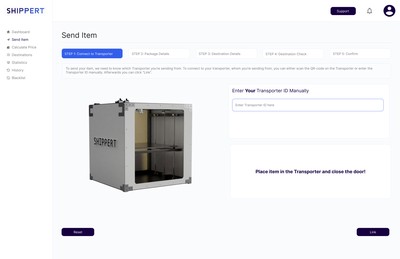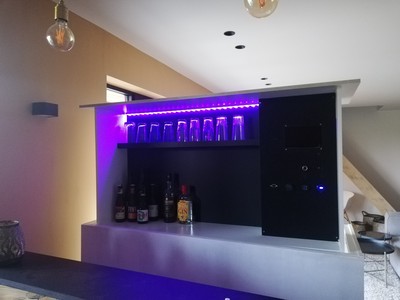Table of Contents
Projects
Major projects I’ve worked on over the years, both solo and as part of a team.
Work with businesses isn’t shown here to protect their intellectual property
2023 • KORTRIJK
The interactive energy monitoring dashboard, “City of Things”, is designed for the City of Kortrijk, Belgium, focusing on the real-time display of energy consumption data for the “Kortrijk Weide” area.
This project utilizes VueJS for its front-end web interface, providing a responsive and interactive experience. Data visualization is powered by Grafana, a leading BI tool that excels in handling time-series data for dynamic and insightful dashboard displays. The content management is streamlined through Strapi, a flexible headless CMS that facilitates content administration and integration. The backend relies on InfluxDB, a specialized time-series database, ensuring efficient data handling and retrieval for continuous real-time analytics. This integrated technology stack enables Kortrijk’s citizens to access and interact with energy usage statistics efficiently and effectively.
2023 • HOWEST
“ParkWise” is an advanced project developed by students to transform parking experiences using modern technology. This intelligent parking management system incorporates Edge Computing for fast local data processing and an AI-driven ANPR (Automatic Number Plate Recognition) model to streamline vehicle identification and registration. Communication is facilitated through HTTP and MQTT protocols, ensuring robust data transfer.
The system’s architecture spans multiple cloud platforms including Azure, AWS, and DigitalOcean, providing scalable resources and high availability. It leverages a dual CMS approach with Strapi for content flexibility and HubSpot for enhanced customer engagement. Backend services are managed via Laravel, a powerful RESTful API framework.
On the frontend, “ParkWise” utilizes OutSystems for fast application development alongside React for interactive web interfaces. The desktop version runs on Electron, supporting cross-platform usability. IoT functionalities are implemented using Flask in Python and C programming, optimizing device interactions. Version control is meticulously handled through Git with repository management on GitLab, ensuring collaborative and trackable development progress.
2022 • HOWEST
The fictional “Shippert” application is designed for a high-speed delivery system on Mars, set in the year 2049. It uses cutting-edge technology to facilitate the transport of goods by disassembling items into molecules and transmitting them through pipelines to their destination. At the receiving end, these molecules are reassembled into their original form.
The system includes:
- Web Interface: Developed using VueJS, which provides user-friendly interface for users to manage their deliveries.
- Backend API: A RESTful API built with Java using the VertX framework, optimized for real-time data handling between the web interface and delivery system.
- IoT Device Integration: Uses Flask to manage interactions with the “transporter” devices that are installed in each dome or residence on Mars.
This setup aims to revolutionize package delivery on Mars by offering rapid, reliable service regardless of the size or type of item being transported.
2021 • PRIZMA
This automated electronic cocktail bar involves mechanical, electrical, and programming components.
Core Technologies and Features:
- Firmware: Utilizes C/C++ programming on Arduino, providing the foundational control logic for the system.
- Controller Boards: Custom-designed by me, these boards manage the various functions of the cocktail bar.
- Sensors: Multiple sensors are integrated for various operational feedbacks such as temperature, position, and gas detection.
- Web Interface: A simple yet effective interface developed with Vanilla JavaScript allows for user interaction with the cocktail bar via a web platform.
- Actuation System: The bar uses a 12VDC linear actuator controlled by a custom-designed** H-bridge** circuit board for linear movements, opening and closing the bar. This setup supports up to 15A - of current, with additional cooling provided by two 12VDC fans.
- Microcontrollers: Two AtMega328 microcontrollers split duties; one manages essential functions like the bar’s movement, while the other handles optional features like lighting and alerts.
- Additional Components: Includes an RFID Reader/Writer for secure access, a push button for manual operation, RGBW LED-strip for ambiance, temperature and gas sensors for safety, a potentiometer to adjust lighting, a buzzer for alerts, and reed contacts to detect the bar’s position.
This project exemplifies an advanced implementation of embedded systems in a practical application, highlighting custom circuit design, firmware development, and integration of multiple electronic components and sensors to create a fully functional automated cocktail bar.
Achievements
Won the ‘Public Favorite’ award for my challenge at the 10th edition of Hack the Future, organized by Cronos Group on November 9, 2023. Held at the Flanders Meeting & Convention Center, the event themed ‘Jungle Expedition’ drew 683 students from 19 colleges and universities. I tackled the ‘Jungle Hike Logger’ challenge, coached by Optis, which involved creating a tracking solution for hikers. The day included a thematic lunch and a hike in the Zoo of Antwerp. This was my first hackathon participation.

